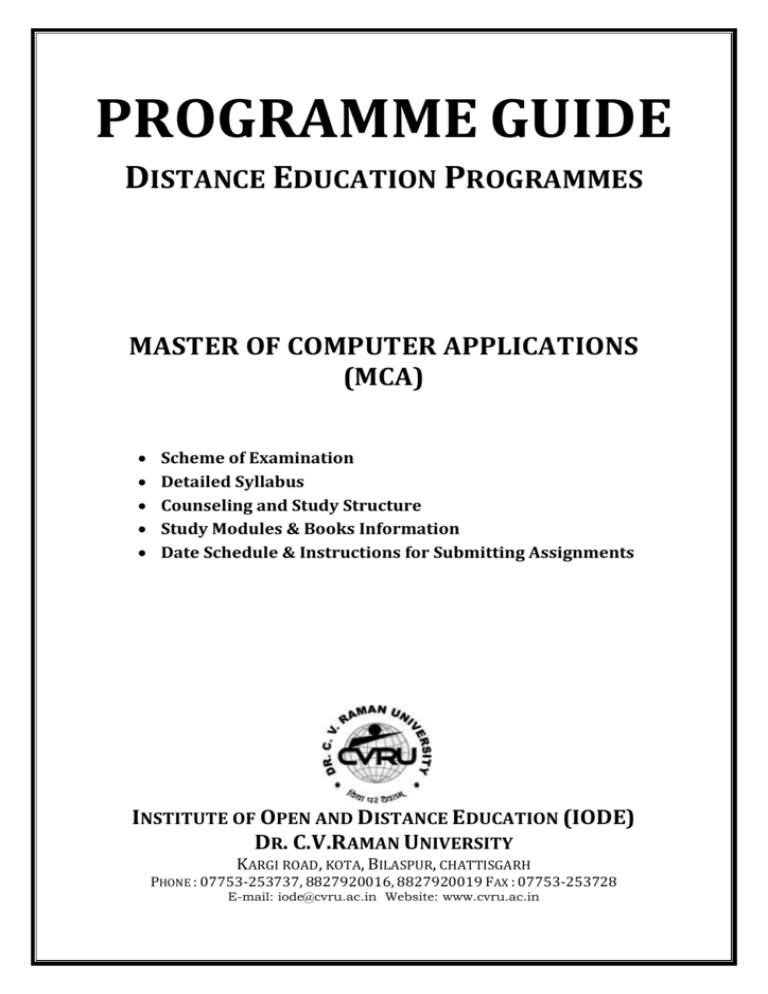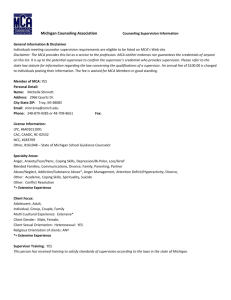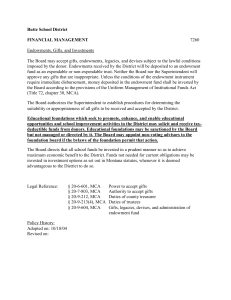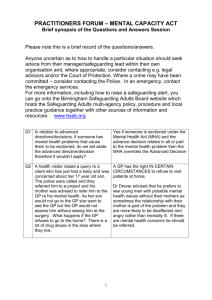MCA - Aisect Baikunthpur
advertisement

PROGRAMME GUIDE DISTANCE EDUCATION PROGRAMMES MASTER OF COMPUTER APPLICATIONS (MCA) Scheme of Examination Detailed Syllabus Counseling and Study Structure Study Modules & Books Information Date Schedule & Instructions for Submitting Assignments INSTITUTE OF OPEN AND DISTANCE EDUCATION (IODE) DR. C.V.RAMAN UNIVERSITY KARGI ROAD, KOTA, BILASPUR, CHATTISGARH PHONE : 07753-253737, 8827920016, 8827920019 FAX : 07753-253728 E-mail: iode@cvru.ac.in Website: www.cvru.ac.in MASTER OF COMPUTER APPLICATIONS (MCA) Course Code Name of the Course Semester- I MCA1 Computer Organization and Architecture MCA2 Mathematical Foundation MCA3 Programming in C MCA4 Operating System MCA5 Accounting and Financial Management TOTAL Semester- II MCA6 System Analysis and Designing MCA7 Data Structure and Application MCA8 Numerical Computation and Statistical Methods MCA9 Business Data Processing MCA10 Object Oriented Programming Analysis and Designing TOTAL Semester- III MCA11 Database Management System MCA12 Computer Communication Networks MCA13 Communication Skills MCA14 Advanced Unix Programming MCA15 Operation Research TOTAL Semester- IV MCA16 Software Engineering MCA17 Programming in Java MCA18 Computer Graphics and Multimedia Management MCA19 Management Information System TOTAL Semester- V MCA20 Artificial Intelligence and Expert System MCA21 Linux MCA22 Visual Basic Programming MCA23 Theory of Computation MCA24 Internet and Web Page Design TOTAL Semester- VI MCA25 Project TOTAL Credit Total Marks Theory Max Min Practical Marks Max Min Max Min 4 100 50 18 20 8 30 11 3 3 3 3 100 100 100 100 50 50 50 50 18 18 18 18 20 20 20 20 8 8 8 8 30 30 30 30 11 11 11 11 500 250 100 100 40 150 60 3 100 50 18 20 8 30 11 3 100 50 18 20 8 30 11 3 100 50 18 20 8 30 11 3 4 100 100 50 50 18 18 20 20 8 8 30 30 11 11 500 250 100 100 40 150 60 3 100 50 18 20 8 30 11 3 100 50 18 20 8 30 11 3 4 100 100 50 50 18 18 20 20 8 8 30 30 11 11 3 100 500 50 250 18 100 20 100 8 40 30 150 11 60 4 4 4 100 100 100 50 50 50 18 18 18 20 20 20 8 8 8 30 30 30 11 11 11 4 100 50 18 20 8 30 11 400 200 80 80 32 120 48 4 100 50 18 20 8 30 11 3 3 3 3 100 100 100 100 50 50 50 50 18 18 18 18 20 20 20 20 8 8 8 8 30 30 30 30 11 11 11 11 500 250 100 100 40 150 60 100 100 - - 100 100 36 36 - - 16 EVALUATION SCHEME 1. 36% in each theory, practical, project, dissertation & internal assessment 2. 40% Aggregate marks to pass Assignments DETAILED SYLLABUS SEMESTER - I MCA1 - COMPUTER ORGANISATION AND ARCHITECTURE Introduction: Basic structure of computers-Machine Instructions and Programs: Memory Locations and Addresses, Memory Operations, Instructions and Instruction Sequencing, Addressing Modes, Basic Input Output Operations, Subroutines. Input/Output Organization: Accessing I/O Devices, Interrupts: Interrupt Handling, Handling Multiple Devices, Vectored Interrupts, Interrupt Nesting, Daisy Chaining, Direct Memory Access (DMA), Buses, Introduction to I/O Interfaces The Main Memory: Memory Hierarchy, Main Memory, RAMROM, Cache Memory, Performance Considerations, Virtual Memory, Memory Management Requirements, Secondary Storage. Central Processing - Arithmetic & Logic Number Representation, Addition of Positive Numbers, Fast Adders, Signed Addition and Subtraction, Multiplication of Positive Numbers, Multiplication using Booth's Algorithm, Fast Multiplication, Floating Point Numbers and Operations. The Processing Basic Concepts, Instruction Execution Cycle, Sequencing of Control Signals, Hardwired Control, PLAs, Microprogrammed Control, Control Signals, Microinstructions, Microprogram Sequencing, Branch Address Modification, Pre Fetching of Microinstructions Introduction to Parallel Processing: Parallel Processing, Principles and Classification, Pipelining, Arithmetic Pipeline, Instruction Pipeline, Vector Processing, Array Processors, Multiprocessors- Comparison of RISC and CISC. MCA 2 - MATHEMATICAL FOUNDATION Sets: Basic Concepts. Relations: Binary relations, Equivalence relations and partition. Functions: Different types of functions, Composition and inverse, Recursive functions, Mathematical induction. Partial Ordering Relations Partially Ordered Set: Representation of Poset, Hasse diagram, LUB, GLB, Well ordered set, Meet and join of elements. Lattices as Partially Ordered Sets: Definition and basic properties, Distributive lattices and complimented lattices. Boolean Algebra: Definitions, Basic theorems and postulates. Basic Concepts of Automata Theory: Alphabets, strings, power of , languages, DFA, NFA and their representations. Logic: Mathematical logic, Logical operators, Conjunction, Disjunction, Negation, Conditional and biconditional, Truth tables, Equivalence formula, tautology, Inference theory, Validity by truth table, Rules of inference, Predicate calculus. Graph Theory: Basic terminology, Different types of graphs – directed and undirected, Simple, Multi, Pseudo, Complete, Regular, Bipartite, incidence and degree, Pendant and isolated vertex and Null graph, isomorphism, Sub graphs, Walk, Path and circuit, Connected and disconnected graphs and components, Euler graphs, Fleury’s algorithm, Hamiltonian circuits and paths, Travelling salesman problem, Matrix representation of graphs, Incidence and adjacency matrices. Trees and Planar Graph Trees: Basic properties, Rooted and binary trees, Path length, Spanning trees, Prims and Kurskals algorithm. Planar Graphs: Kuratowski’s two graphs and Euler’s formula – Statement and corollary, Detection of planarity. MCA 3 - PROGRAMMING IN C Introduction to programming: Programming languages, Compiler, interpreter, loader and linker, program execution, fourth generation language, fifth generation language, structured programming concept, algorithm and flowchart. Introduction to C Language: The C character set, identifiers and keywords, data types, how floats and doubles are stored, constants, variables and arrays, declarations, expressions, statements, Lvalues and Rvalues, type conversion, symbolic constants. Operators and expressions: Arithmetic operators, unary operator, relational and logical operator, assignment operators, the conditional operator, , type conversion, Library function. Data input and output: Single character input, single character output, scanf, printf, puts gets functions, interactive programming. Control statement: Branching: if else statement, Looping, nested control structure, switch statement, break statement, continue statement, comma operator, goto statement. Functions: Overview, function prototypes, passing arguments to a function, recursion. Program structure: Storage classes, automatic variables, external variables, static variables, multifile program, Arrays: Defining an array, passing array to functions, multidimensional arrays, strings: one dimensional character array, array of strings. Pointers: Fundamentals, void pointer, null pointer, passing pointers to a function, pointers and one dimensional arrays, dynamic memory allocation, operation on pointers, pointers and multidimensional arrays, array of pointers, pointer to an array, pointers and strings, structure pointer, pointers to function, pointers and variable length arguments list, passing functions to other functions, offsetting a pointer. Structures and unions: Defining a structure, processing a structure, user defined data types, structure and pointers, passing structure tofunction, self-referential structures, and union. Data files: Why files, opening and closing a data file, reading and writing a data file, processing a data file, unformatted data file, concept of binary file. Low level programming: Register variable, bitwise operations, bit fields. Addition a features of C: Enumeration, Command line parameters, macros, the c Preprocessor. MCA 4 - OPERATING SYSTEM Evolution of Operating Systems: Serial processing, batch processing, multiprogramming, types of operating systems, batchmultiprogramming, time sharing, real time and distributed operating systems. File Management: File structure, file types, file access, file attributes, file operations, directories, flat directory systems, hierarchical directory systems, file system implementation-allocation methods-contiguous allocation, linked allocation, indexed allocation. Processor Management: Job and process concept, concurrent processes, operating system view of processes, process-state transition diagram, PCB (Process control block), threads, process scheduling, operations on processes, operating system services. Process Scheduling: Types of schedulers, scheduling and performance criteria, scheduling algorithms, multiple processor scheduling Inter-process Synchronization and Communication: Concurrent processes, precedence graph-hierarchy of process, need for inter process synchronization, critical section problem, mutual exclusionmutual exclusion algorithms, semaphores-definition busy wait implementation, hardware implementation of semaphores-test monitors, inter process communication using messages. and set instruction, Memory Management: Preliminaries, address binding, dynamic linking and loading, overlays, logical versus physical address space, swapping, contiguous allocation pagingprinciples of page allocation, structure of page table- hardware support, multi level paging, hierarchical paging, inverted page table, shared pages. Segmentation: Principles of operation, hardware, implementation of segment table, protection and sharing, fragmentation, segmentation with paging. Virtual Memory: Demand paging, performance, page replacementpage replacement algorithms, thrashing, segmentation and paging implementation of virtual memory, hierarchical address translation tables and MMUS. Deadlocks: Definition, deadlock characterization, resource allocation graph, methods for handling deadlocks, deadlock prevention, deadlock avoidance, safe state, resource allocation graph algorithm, Banker’s algorithm, deadlock detection, recovery from deadlock, combined approach to deadlock handling. Device Management: Disk structure, Disk scheduling-FCFSSSTF- C-Scan-Look, Disk management, Swap space management, Disk Reliability, Protection-Goals of Protection, Policies and Mechanisms-Access Matrix and its Implementations, Dynamic ProtectionLanguage base Protection. Security-Security. . MCA 5 - ACCOUNTING AND FINANCIAL MANAGEMENT Accounting: Meaning and definition, Accounting concepts and conventions, Basic accounting terms, Rules for debit and credit, Recording of transactions- Journal, Ledger, Trial balance, Preparation of final accounts, Trading and profit and loss accounts, Balance sheet, Classification of assets and liabilities, Final accounts with adjustments, Outstanding expenses, Prepaid expenses, Income received in advance and accrued incomes, Depreciation, Bad debts and provision for bad and doubtful debts, Interest on capital, Interest on drawings and closing stock. Analysis to financial statements, Ratio analysis, Advantages and limitations of ratio analysis, Liquidity ratios. Long term solvency ratios, Profitability ratios, Activity ratios. Capital Budgeting: Need for capital resources allocation, Investment criteria decisions, Pay back period method, Average rate of return method, Internal rate of return method, Net present value method and profitability index. Budgetary Control: Meaning and need for budgets, Budgetary control, Objectives of budgetary control, Advantages and limitations of budgetary control system, Different types of budgets, Sales budget, Production budget, Cash budget, Fixed budget and flexible budgets only. Computer Based Accounting Package: TALLY, Company information, Accounts information, Ledger, Account Group, Voucher entry, Profit and loss account, Balance sheet, Ratio analysis, Cash and fund flow. SEMESTER - II MCA 6 - SYSTEM ANALYSIS AND DESIGN Overview of system analysis and design. Business systems concepts, system development life cycle, project selection, feasibility, analysis,design, implementation, testing and evaluation. Project Selection: Source of Project requests, managing project review and selection, preliminary investigation. Feasibility Study: Technical and economical feasibility, cost and benefit analysis System requirement specification and Analysis: Fact finding techniques, Data flow diagrams, data dictionaries, process organisation and interactions, Decision analysis, decision trees and tables. Detailed design modularisation, modula specification, file design, system development involving data bases. System Control and Quality: Assurance4-Design objectives reliability and maintenance, software design and documentation tools top down , bottom up and variants, UNITs and intergration testing, testing practices and plans. System Controls, Audit trails. System Administration and Training: conversion, and operation plans. Hardware and Software Selection: Hardware acquisition, memory process, peripherals, bench marking, vendor selection, software selectionoperating system languages, language process, performance and acceptance criteria. MCA 7 - DATA STRUCTURE AND APPLICATION Introduction to Data structure, Primitive and composite data types, Abstract Data Type Time and space complexity of algorithms, Concept of , Big-O, Small-o and Big-Omega notations. Linear List, Arrays, Stacks, Queue, Circular Queue, Priority Queue. Singly Linked List, Doubly Linked and Circular Linked List. Introduction to Trees, Properties of Trees, Binary Trees, Extended binary trees, Complete binary trees, Binary search trees, Weight balanced and Height balanced trees, AVL trees, Threaded Binary trees, B-Trees, Heap. Introduction to graph, properties of graphs, connected graph, Sequential Representation of Graphs: Adjacency Matrix, Path matrix, Warshall’s algorithm, Linked Representation of Graphs: Adjacency list, Graph Traversal: Depth-first and Breadth-first. Spanning trees, Minimum Spanning tree, Prim's and Kruskal's algorithms. Selection sort, Insertion sort, Bubble sort, Radix sort, Quick sort, heap sort, merge sort. Searching Techniques: Binary search, Linear search, Hashing. MCA 8 - NUMERICAL COMPUTATION & STATISTICAL METHODOLOGY Matrix Algebra: Introduction of a Matrix, its different kinds, Matrix Addition and Scalar Multiplication, Multiplication of Matrices, Square Matrix, Rank of a Matrix, Transpose, Multiplication, Multiplication of Matrices, Square Matrix, Rank of a Matrix, Transpose, Adjoint and Inverse of a Matrix, Solving Simultaneous Equations using Gauss Elimination Method, Gauss Jorden Method and Matrix Inversion Method. Statistics: Measures of Central Tendency. Preparing Frequency Distribution Table, Arithmetic Mean, Geometric Mean, Harmonic Mean, Median and Mode. Measures of Dispersion: Range, Mean Deviation, Standard Deviation, Co-efficient of Variation, Moments, Skewness and Kurtosis. Differential Calculus: Introduction, Differentiation, Derivative of a Function of One Variable, Power Function, Sum and Product of Two Functions, Function of a Function, Variable, Power Function, Sum and Product of Two Functions, Function of a Function Differentiation by Method of Substitution, Maxima and Minima. Integral Calculus: Indefinite Integral, Integration by Substitution, Integration by Parts, Integration by Partial Fractions, Definite Integral. Numerical Integration: Trapezoidal Method, Simpson’s 1/3 Rule, Simpson’s 3/8 Rule. MCA 9 - BUSINESS DATA PROCESSING Introduction to Data Processing Introduction to Data and Information, Logical and Physical Concept of Data, File Organization, Different Systems of Data Processing, Business Data Processing (Identification of Data, Classification of Business Data File, Data Security, Data Integrity and Type of Checking, Basic Task in Business Data Processing, File Generation, File Backup). Business Accounting Accounting, Accounting Conventions (Single and Double Entry), Basic Accounting Equation, Types of Accounts, Personal Accounts, Impersonal Accounts, Real, Nominal, Terms in Accounting, Assets, Liabilities, Capital, Goods, Debtor, Creditor, Gross Profit, Net Profit, Revenue, Expense, Types of Vouchers, Journal Entries, Final Accounts, Trading/Manufacturing Account, Profit/Loss Account, Balance Sheet, Schedule to Final Account. Introduction to Access Introduction to Database, DBMS, RDBMS, Feature of Access, Designing Database, Relationship (One to One, One to Many, Many to One, Many to Many), Create Table (Design View, Wizard, Datasheet View), Query (Update Query, Delete Query, Selection Query, Cross Table Query, Make Table Query). Forms, Reports and Labels Create (Manually, Form Wizard, AutoForm), Sorting, Filtering, Report Creation (Design View and Wizards), Report using Single Tables/Multiple Tables/Queries, Labels.. MCA 10 - OBJECT ORIENTED PROGRAMMING ANALYSIS AND DESIGN UNIT-I Introduction to Oops: Encapsulation, Data Abstraction, Inheritance, Polymorphism, message Passing, Extensibility Introduction to C++: Function, Variables, Arithmetic operators UNIT-II Loops and Decisions: Relational Operators, Loop, and Logical operators Structures : Simple structure, Initializing structure variables, Accessing Nested structure member Enumerated data types. Function: Simple functions, Function declaration Function Call, Function definition, Overloaded function Arrays: Defining Arrays, Multidimensional Arrays, Arrays of Structures. UNIT-III Object and Classes: Class, Objects, Constructors, Deconstructors. Operator: Operator overloading, overloading ...operators, Overloading Binary Overloading operators UNIT-IV Inheritance: Defining Arrays, Multidimensional Arrays, Arrays of Structures. Graphics: Text mode graphic Function, Graphic mode, Graphic function, Graphic driver UNIT-V Pointer: Address and Pointers, Pointers and Array. SEMESTER - III MCA 11 - DATABASE MANAGEMENT SYSTEM Introduction To Database Systems and E-R Model Overview, A Historical Perspective, Files System versus DBMS, Advantages of DBMS, Describing and storing data in a DBMS Transaction management, Structure of a DBMS, People who work with Databases, Overview of Database Design. Entities, Attributes and Entity Sets, Relationships and Relationship sets, Additional Features of E-R Model: Key Constraints. Conceptual Design with the E-R Model, Overview of Unified Modeling Languages Relational Model and Query Languages Introduction to the Relational Model. Integrity Constraints over Relations: Primary Key, Foreign Key and General Constraints. E-R Model to Relational Model: Entity Sets to Tables, Relationship Sets to Tables, Translating, Relationship Sets with Key Constraints. Translating Relationship Sets with Participation Constraints, Translating Weak Entity Sets, Translating Class Hierarchies. Translating E-R Diagrams with Aggregation, Introduction to Query Languages, Relational Algebra: Selection and Projection Operations. Set Operations, Renaming, Joins, Division Structured Query Language Overview of SQL, Basic Queries in SQL, Union, Intersect and Except, Nested Queries, Aggregate Operators, Null Values, Complex Integrity Constraints in SQL, Triggers and Views in SQL, Embedded SQL and Cursors Relational Database Design Introduction to Schema Refinement, Functional Dependencies, Properties of Decomposition, Normal Forms: First Normal Form, Second Normal Form, Third Normal Form, Boyce Codd Normal Form, Fourth Normal Form, Fifth Normal Form Transaction Management, Concurrency Control and Distributed System The ACID Properties, Transactions and Schedules, Concurrent Execution of Transactions: Serialisability, Anomalies Due to Interleaved Execution. Schedules Involving Aborted Transactions, Lock-Based Concurrency Control: 2 PL – Basic & Strict, Dead Locks, Introduction to Crash Recovery, Concurrency Control:2 PL, Serialisability, and Recoverability,: Introduction to Locking Management: Dealing with Deadlock .Introduction to ARIES, Introduction to Distributed Databases: Advantages & Disadvantages, Transaction Types – Local & Global Transactions, Distributed DBMS Architectures, Design of Distributed Databases: Replication, Fragmentation. MCA 12 - COMPUTER COMMUNICATION NETWORKS Data Communications: Multiplexing, Signaling, Encoding & Decoding, Error Detection & Recovery, Flow Control, Sliding Window, Congestion Management. Communication Networks: Introduction to networking, OSI Model for Networking, Internet, ATM, Network Components (Cables, Hubs, Bridges, Switches , Routers), Network Topologies, Shared Medium, Peer to Peer, Hybrid Technology. Network Technologies: Local Area Network Technologies, Ethernet Technologies, Ethernet Versions, Token Ring Technologies, Wide Area Network Technologies (Frame Relay, SMDS, ISDN, SONET, PPP, HDLC, LLC), Wireless Networks (Radio Frequencies, Microwave Frequencies, Infrared Waves. Multiple Access: Design Issues, Distributed & Centralized Design, Circuit Mode & Packet Mode Design, Implementation Issues, Performance Considerations, Base Technology (FDMA, TDMA, CDMA, Centralized Access, Circuit Mode Access, Poling or Packet Mode Access, Reservation Based Access), Distributed Access (decentralized polling, CSMA, CSMA/ CA, CSMA/CD, Busy Tone Multiple Access & Multiple Access Collision Avoidance, Token Passing, ALOHA, Slotted ALOHA, Reservation ALOHA), Hardware Addressing Switching: Circuit Switching (Time Division switching, Space division switching, time space switching, time space time switching), Packet Switching (Port Mappers, Blocking, ATM Switching, Switching Fabric (Crossbar, Broadcast, Switching Fabric Elements), Bridges (Transparent bridges, Spanning Tree Algorithm, Virtual LANS), Switches. Naming & Addressing: Hierarchical Naming, Addressing, Telephone Networks, Internet, IPv4, Subnetting Ipv4 Networks, Private Networks, Asynchronous Transfer Mode, Name Resolution, Address Resolution Protocol (ARP), RARP Routing: Routing Information, Routing Protocols, Hierarchical Routing, Multicast Routing. Services & Applications: File transfer protocol, TFTP, Domain Name System, DHCP, SNMP, Electronic Mail, WWW, HTML, HTTP, RPC & Middleware. Security: Threats, Encryption/Decryption, Firewalls, IP Security, Web Security, Email Security. MCA 13 - COMMUNICATION SKILL Communication- Channels, Technical Communication, Importance. Listening Process, Types, Improving Listening Process. Speaking, Speech Process, Strategies for good communication, Improving fluency, Body Language, Professional Speaking, Job Interviews, Group Discussions. Presentation Skills, Professional Writing, Résumés and job applications, Email messages, Reports. PAPER 14 - ADVANCED UNIX PROGRAMMING UNIT-I The File System: The basics of files, What's in a file?, Directories and filenames, Permissions, Inodes, The directory hierarchy, Devices. Using the Shell: Command line structure, Metacharacters, Creating new commands, Command argument and parameters, Program output as arguments, Shell variables, More on I/O redirection, Looping in shell programs, bundle: putting it all together, Why a programmable shell? UNIT-II Filters: The grep family, Other filters, The stream editor sed, The awk pattern scanning and processing languages, Good files and good filters. Shell Programming: Customizing the cal command, Which command is which? While and until loops: watching for things, Traps: catching interrupts, Replacing a file: overwrite, zap: killing processes by name, The pick command: blanks vs. arguments, The news command: community service messages, get and put: tracking file changes. UNIT-III Programming with Standard I/O: Standard input and output: vis, Program arguments, File access, A screen-at-a-time printer: p, on bugs and debugging, An interactive file comparison program, Accessing the environment. UNIT-IV Unix System Call: Low level I/O, File system: directories, File system: inodes, Processes, Signals and interrupts. UNIT-V Program Development: Stage 1: A four-function calculator, Stage 2: Variables and error recovery, Stage 3: Arbitrary variable names; built-in functions, Stage 4: Compilation into a machine, Stage 5: Control flow and relational operators, Stage 6: Functions and procedures; input/output, Performance evaluation. Document Preparation: The ms macro package, The troff level, The tbl and eqn preprocessors, The manual page, Other document preparation tools. MCA 15 - OPERATION RESEARCH Nature and scope of operations research, problem, formulation, model construction, deriving solutions from models. Sensitivity analysis, allocation problems, assignment and distribution problems. Linear allocation problems, inventory problems. Replacement and maintenance and reliability problems, dynamic programming, cure in problems. Co-ordination (PERT and critical path) method and routine problems, competitive problems, simulation and problems of implementation. . SEMESTER - IV MCA 16 - SOFTWARE ENGINEERING Introduction to Software Engineering Challenges and approaches. Software Development Process Models: Waterfall model, prototyping, iterative, time boxing. Software Implementation and Management Process: inspection, configuration, change management. Software Requirement, Architecture and Planning Problem analysis, requirements specification, functional specification with use case, validation and quality matrix, component and connector view, styles for component and connector view, evaluating architectures. Planning a software project- effort estimation, scheduling, configuration management, quality, risk and monitoring. CASE Tools Documentation Tools, Analysis and Design Tools. Programming Tools: Integration, implementation and testing tools. Maintenance Tools: Integrated case environment. Specification Phase: Informal specifications, structured system analysis, relationship modeling, finite state machines, petri nets, formal techniques. entity Function Oriented Design: vel concepts, structured design methodology Object Oriented Analysis and Design Phase Object oriented analysis- class modeling, dynamic modeling, challenges of object oriented analysis. Design phase, design abstraction, action oriented design, transaction analysis, formal techniques for detailed design, challenges of the design phase. Implementation, Testing and Maintenance Coding: guidelines, refactoring, verification, complexity metrics. Programming principles and Testing: Black box testing, white box testing process, defect analysis, reliability estimation. Maintenance: Why maintenance is necessary? management of maintenance, challenges of maintenance phase.. MCA 17 - PROGRAMMING WITH JAVA Programming through JAVA: JAVA history, JAVA features, JAVA and internet, JAVA and WWW, hardware and software requirements, JAVA environment, program structure, JAVA tokens, JAVA virtual machine, constants, variables and data types, operators and expressions, decision making and branching, decision making and looping. Classes, objects and methods, interfaces, packages, managing errors and exceptions, multithreading. Applet Programming, Applets and Applications, etc. String handling, event handling, AWT: Working with windows, graphics and text, controls, layout managers. MCA 18 - COMPUTER GRAPHICS AND MULTIMEDIA Overview of Graphics System: Display devices, Raster scan systems, Random scan systems, Input devices, Graphics software. Output Primitives: Points and lines, line drawing algorithms, DDA, Bresenhams line algorithm, Circle generating algorithms, Bresenhams, Mid-point, Filled area primitives. Attributes of Output Primitives: Line, Curve, Area fill, Character text, Marker Antialiasing. 2-D Transformations: Basic transformations, Matrix representations and Homogeneous coordinates, Composite transformations, Reflection, Shear. 2-D Viewing: Viewing pipeline, Window to viewport coordinate transformations, Clipping operations, Point, line-Cohen Sutherlands, Polygon clipping-Hodgemans, Weilor-Atherton, curve, text. Structures: Concepts, basic modeling concepts, Interactive graphics, Logical classification of input devices, Input functions, interactive picture construction techniques. 3-D Concepts: Introduction to 3-D graphics, Display methods, 3-D representations-polygon surfaces. Definition of Multimedia; Applications, Hardware and Software requirements for creating multimedia; Building blocks of multimedia – text, Graphics (image), Video, Audio, Animation; Different types of animation; Brief overview of stages in execution of multimedia project – pre production, Production and post production phases. What is Compression; Lossy and Lossless compression; Compression techniques – RLE in text and image, LZW, Huffman's Coding, GIF, JPEG, MPEG, Fractal, Wavelet; Image File types; Advanced Multimedia – Virtual Reality, Augmented Reality, Video, Conferencing, Morphing, VoIP, Video on Demand. MCA 19 - MANAGEMENT INFORMATION SYSTEM Techniques in data processing — Online Batch Mode – Real Type. System analysis, Input Design, Output Design, File Design– Introduction to Internet and other emerging technologies. MIS Meaning – Scope and role in modern management, Fundamental concepts in MIS – Computer based MIS. Office automation – String and filing data – System Implementation – Transaction Processing Systems – Decision Support Systems. Organizational Changes – Information System Design – Business process redesign – Business Transformation – distributed databases and MIS – Computer Networks and ECommerce. SEMESTER - V MCA 20 - ARTIFICIAL INTELLIGENCE & EXPERT SYSTEM State space search: Production systems, Search space controll Depth first search, unknown search- Hill climbing best first search, branch and bound. Best First Search, Problem Reduction, Constraints, Satisfaction, Means End Analysis. Knowledge Representation Predicate Logic: Skolemzing queries, Unification, Modus pones, Resolution, dependency directed back tracking. Rule Based Systems: Forward reasoning Conflict resolution, Backward reasoning. Use of non back track. Structured Knowledge Representation Semantic Net : Slots exceptions and defaults frames Handling uncertainty Probabilities Reasoning, Use of certainty factor, Fuzzy logic Learning: Concept of learning, (7.3) learning automation, genetic algorithm, learning by induction, neural nets back propagation Experts Systems: Need and justification for expert systems, Knowledge acquitions, Case studies MYCIN, RI . MCA 21- LINUX Introduction to Linux: History, Architecture, Comparison with UNIX, Features and Facilities of Linux, Shells in Linux, Different Variants of Linux — Red Hat, Ubuntu, Mandrake, Debian, Susse. Files and File Structure: Linux File System, File naming Conventions, Path, Types of File Names and Users, Directory Commands, File Commands in Linux, Text Editors-Functions of a Text Editor, Various Editors, vi Editor, emacs Editor, joe Editor, Locating Files, Standard Files, Redirection, Filters, Pipes. File Access Permissions [FAP]: Viewing and Changing FAPs, Introduction to Shells, Shell Variables- Local and Global Variables, Command Substitution - expr Command, Arithmetic Expansion, Conditional Execution Constructs, Iterations, Parameter Handling in Shell Scripts, Shift Command, Controlling Process Execution, Sheduling Tasks. Backup: Restore and Compress Utilities, tar, cpio, dump and Restore Utilities, Communication in Linux — mesg, who-T, talk, write, wall, finger, chfn, ping, traceroute utilities, FTP , ncftp Command, e-mail Facilities. Window System: X Desktop, GNOME Desktop Environment, Features, GNOME Panel, Control Center— Capplets, Document Handlers, Multimedia Capplet, Peripherals, File Manager K Desktop environment — Interface, Desktop, Panel, Konqueror, Koffice, Kmail, KDE Control Center, Kjots, Kdiskfree. MCA 22 - VISUAL BASIC INTRODUCTION TO VB VB: An Overview, Concept of GUI, How to Start With a Project, Properties Windows and Project Windows, Toolbox Windows, Menubar Windows. PROGRAMMING BASIC VB Variables, Constants, Arrays, Inputbox()and Msgbox() Functions, Control Flow Statements, Loop Statements, Procedures and Subroutines, BuiltIn Functions. WORKING WITH CONTROLS Label and Textbox, Text Selection Controls, Capturing Key Strokes, Using Controls. DESIGNING THE USER INTERFACE Placing the Controls on Form, Aligning and Grouping Controls, Setting Focus, Writing Code with Code Design Window, Saving and Running the Application. ADVANCED ACTIVEX CONTROLS The Common Dialog Controls, The TreeView Controls, How Tree Structure Works, Using the TreeView. THE MULTIPLE DOCUMENT INTERFACE MDI: An Overview, Built-In Capabilities of MDI, Parent and Child Menus, Creating Menus with Menu Editor and Assigning Keys. DATABASE PROGRAMMING & ERROR HANDLING Understanding Databases and Database Management Systems, Record Sets, Accessing Fields in a Database, Data Control — Properties and Methods, Advanced Data Bound Control, Using Visual Data Manager, Database Connectivity With Controls ADO, Establishing Connection, Executing SQL Statements, Cursor Types and Locking Mechanisms, Manipulating Record Set Object, Database Connectivity Using Code, Grid Controls, Handling Errors. REPORTS Data and Crystal Reports, Creating DLL in VB, Making EXE File. . MCA 23 - THEORY OF COMPUTATION UNIT-I Review of Mathematical Preliminaries, Relations, functions, set theory, predicate & prepositional calculus, principle of mathematical induction/strong mathematical induction. UNIT-II Formal Languages, Phrase structured grammar & their classification, Chomskey hierarchy, closure properties of families of languages, regular grammar, regular expression properties of regular sets, finite automata, DFA & 2DFA, FSM with output, Determinism & Non determinism, FA minimization & related theorems. UNIT-III Context free grammar & its properties, derivation tree simplifying CFG, unambiguifying CFG, CNF & GNF of CFG, push down automata, 2 way PDA, relation of PDA with CFG, Determinism & Non determinism in PDA & related theorems. UNIT-IV Concept of Linear Bounded Automata, context sensitive grammars & their equivalence. UNIT-V Unrestricted grammars & their equivalence with TM, determinism & non determinism in TM, TM as acceptor/generator/algorithms & related theorems, Multi tape, multi head, multi track TM, automata with two push down store & related theorems. Introduction to Complexity theory. Recursively enumerable sets, recursive set, partial recursive sets, Russell's paradox, undesirability & some non-computable problems. MCA 24 - INTERNET & WEB PAGE DESIGNING UNIT-I Introduction to Internet: Evolution of internet, internet applications, TCP-IP, introduction to REC, addressing in internet - IP and domains, internet service providers, types of connectivity such as dial-up leased VSAT etc., internet server and client modules on various operating systems. UNIT-II E-Mail and list servers: E-mail networks, E-mail protocols (X-400, SMTP, UUCP), format of an E-mail message, description of E-mail headers, E-mail contents and encoding, e-mail routing, list server, email client, POP-3, IMAP-4. File Transfer protocol: Introduction to FTP, public domain software, types of FTP servers (including anonymous), FTP, clients, common commands. UNIT-III Telnet: Telnet protocol, server domain, telnet client, terminal emulation. Usenet and internet relay chat Web Publishing: Technology overview, website planning, where to host your website, multiple sites on one server, maintaining a web site, publishing tools, WWW servers, HTTP & URL's, how to register a web site on search engines & maintenance. UNIT-IV HTML Document overview, header elements, section headings, block headings, lists, inline elements, visual markup, hypertext links, uniform resource locators, images, forms, tables, special characters, DHTML. UNIT-V Overview of Interactivity tools VB script, ActiveX, VRML Internet Security Internet security threats, firewalls, introduction to AAA. E-Commerce An introduction, concepts & technology in E-commerce, advantages, limitations, various electronic payment system, EDI software agents concerns of E-commerce growth. MCA25 – PROJECT COUNSELING AND STUDY STRUCTURE Sl. No. Course Code Semester I 1 MCA 1 2 3 4 5 MCA MCA MCA MCA 2 3 4 5 Semester II 6 MCA 6 7 MCA 7 8 MCA 8 9 10 MCA 9 MCA 10 Semester III 11 MCA 11 12 MCA 12 13 MCA 13 14 MCA 14 15 MCA 15 Semester IV 16 MCA 16 17 MCA 17 18 MCA 18 19 MCA 19 Semester V 20 MCA 20 21 MCA 21 22 MCA 22 23 MCA 23 24 MCA 24 Semester VI 25 MCA 25 Title of the Course Credit Total Hours of Study Counseling and Study Structure (hours) Face to Self Pra Assign Face study ctic ments Counseling al Proje ct Computer Organization and Architecture Mathematical Foundation Programming in C Operating System Accounting and Financial Management 4 120 16 44 24 36 - 3 3 3 3 90 90 90 90 12 12 12 12 33 33 33 33 18 18 18 18 27 27 27 27 - System Analysis and Designing Data Structure and Application Numerical Computation and Statistical Methods Business Data Processing Object Oriented Programming Analysis and Designing 3 90 12 33 18 27 - 3 90 12 33 18 27 - 3 90 12 33 18 27 - 3 4 90 120 12 16 33 44 18 24 27 36 - Database Management System Computer Communication Networks Communication Skills Advanced Unix Programming Operation Research 3 3 90 90 12 12 33 33 18 18 27 27 - 3 4 3 90 120 90 12 16 12 33 44 33 18 24 18 27 36 27 - Software Engineering Programming in Java Computer Graphics and Multimedia Management Management Information System 4 4 4 120 120 120 16 16 16 44 44 44 24 24 24 36 36 36 - 4 120 16 44 24 36 - Artificial Intelligence and Expert System Linux Visual Basic Programming Theory of Computation Internet and Web Page Design 4 120 16 44 24 36 - 3 3 3 3 90 90 90 90 12 12 12 12 33 33 33 33 18 18 18 18 27 27 27 27 - Project 16 480 - - - - 480 STUDY MODULES AND REFERENCE BOOKS INFORMATION Course Code Semester- I MCA 1 Name of the Course Books / Modules to be used Computer Organization Architecture MCA 2 Mathematical Foundation MCA 3 Programming in C MCA 4 Operating System MCA 5 Accounting Management Semester- II MCA 6 and and Financial System Analysis and Designing MCA 7 Data Structure Application and MCA 8 Numerical Computation Statistical Methods Business Data Processing and MCA 9 MCA 10 Object Oriented Programming Analysis and Designing Semester- III MCA 11 Database Management System MCA 12 Computer Networks Communication MCA 13 Communication Skills MCA 14 Advanced Unix Programming MCA 15 Operation Research Semester- IV MCA 16 Software Engineering Computer Architecture , Sheetanshu Rajoriya, Pragya Publications, [E] Computer Architecture, Sheetanshu Rajoriya, Pragya Publications, [H] Discrete Mathematics, Schaum Series, TMH, [E] Discrete Mathematics, Schaum Series, TMH, [H] Let Us C, Kanetkar, BPB, [E] Let Us C, Kanetkar, BPB, [H] Operating System, Design & Implementation, Tenanbaum, PHI, [E] Operating System, Design & Implementation, Tenanbaum, PHI, [H] Management Accounting, S.P.Gupta, Sahitya Bhavan Publication, [E] Management Accounting , Shashi Gupta &R.K. Sharma, PHI, [H] System Analysis and Design , E.M. Awad, Galgotia Publication, [E] System Analysis and Design, E.M. Awad, Galgotia Publication, [H] Introduction to Data Structure , Shridhar B. Dandin, Pragya publication, [E] Introduction to Data Structure (Hindi), Shridhar B. Dandin, Pragya publication, [H] Numerical Methods , Balaguruswamy, TMH, [E] Numerical Methods, Balaguruswamy, TMH, [H] Business Data Processing System, T.D.Malhotra, Kalyani Publishers, [E] Business Data Processing System, T.D.Malhotra, Kalyani Publishers, [H] Object Oriented Programming With C++, Balaguruswamy, TMH, [E] Object Oriented Programming With C++, Balaguruswamy, TMH, [H] Introduction to DBMS, Shridhar B. Dandin, Pragya Publications, [E] Introduction to DBMS (Hindi), Shridhar B. Dandin, Pragya Publications, [H] Insight in to Computer Network, Ekta Gupta, Pragya Publication, [E] Insight in to Computer Network (Hindi), Ekta Gupta, Pragya Publications, [H] Essentials of Business Communication, Rajendra pal, Sultan Chand & Company, [E] Essentials of Business Communication, Rajendra pal, Sultan Chand & Company, [H] The Unix Programming Environment , Kemighan & Pike, PHI, [E] The Unix Programming Environment, Kemighan & Pike, PHI, [H] Introduction To O.R., Billy E Gillett, TMH, [E] Introduction To O.R., Billy E Gillett, TMH, [H] Software Engineering , Ekta Gupta, Pragya Publications, [E] Software Engineering (Hindi), Ekta Gupta, Pragya Publications, [H] MCA 17 Programming in Java MCA 18 Computer Graphics Multimedia Management MCA 19 Management System Semester- V MCA 20 and Information Artificial Intelligence Expert System and MCA 21 Linux MCA 22 Visual Basic Programming MCA 23 Theory of Computation MCA 24 Internet and Web Page Design Semester- VI MCA 25 Project Concept of Programming in Java , Seetha & Rastogi, Pragya Publications, [E] Concept of Programming in Java (Hindi), Seetha & Rastogi, Pragya Publications, [H] Computer Graphics , Shridhar B. Dandin, Sheetanshu Rajoriya, Pragya Publications, [E] Computer Graphics (Hindi), Shridhar B. Dandin, Sheetanshu Rajoriya, Pragya Publications, [H] Management Information System, Srbhi Rastogi, Pragya Publications, [E] Management Information System, Srbhi Rastogi, Pragya Publications, [H] Artificial Intelligence, Dr. Rama Shushil, Pragya Publications, [E] Artificial Intelligence (Hindi), Dr. Rama Shushil, Pragya Publications, [H] Linux (Server Administration & Shell Programming), Anurag Seetha, Pragya Publications, [E] Linux (Server Administration & Shell Programming) (Hindi), Anurag Seetha, Pragya Publications, [H] Visual Basic in Easy Steps, In Easy Steps, TMH, [E] Visual Basic in Easy Steps, In Easy Steps, THM, [H] Theory of Computation, Natrajan, New Age International Publishers, [E] Theory of Computation, Natrajan, New Age International Publishers, [H] Internet Technology and Web Design , A. Mansoor, Pragya Publications, [E] Internet Technology and Web Design (Hindi), A. Mansoor, Pragya Publications, [H] - DATE SCHEDULE AND INSTRUCTIONS FOR SUBMITTING ASSIGNMENTS DUE DATE OF SUBMISSION OF ALL ASSIGNMENTS AT THE STUDY CENTRE Semester Assignment No. First Semester Second Semester Third Semester Fourth Semester Fifth Semester MCA (1) MCA (2) MCA (3) MCA (4) MCA (5) MCA (6) MCA (7) MCA (8) MCA (9) MCA (10) MCA (11) MCA (12) MCA (13) MCA (14) MCA (15) MCA (16) MCA (17) MCA (18) MCA (19) MCA (20) MCA (21) MCA (22) MCA (23) MCA (24) Due Date April 30 (for January Session) October 31 (for July Session) October 31 (for July Session) April 30 (for January Session) April 30 (for January Session) October 31 (for July Session) October 31 (for July Session) April 30 (for January Session) April 30 (for January Session) October 31 (for July Session) Note: Assignments of the course are available for download at the CVRU Website http://www.cvru.ac.in . You can download the assignments as per your course, follow the instructions given and submit it before due dates at the study centre. due dates at the study centre.








